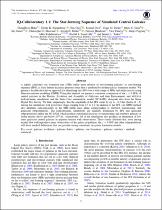| dc.description.abstract | A tightly correlated star formation rate (SFR)–stellar mass relation of star-forming galaxies, or star-forming sequence (SFS), is a key feature in galaxy property-space that is predicted by modern galaxy formation models. We present a flexible data-driven approach for identifying this SFS over a wide range of SFRs and stellar masses using Gaussian mixture modeling (GMM). Using this method, we present a consistent comparison of the z = 0 SFSs of central galaxies in the Illustris, Evolution and Assembly of GaLaxies and their Environment, and MUFASA hydrodynamic simulations and the Santa Cruz semianalytic model (SC-SAM), alongside data from the Sloan Digital Sky Survey. We find, surprisingly, that the amplitude of the SFS varies by up to ∼0.7 dex (factor of ∼5) among the simulations with power-law slopes ranging from 0.7 to 1.2. In addition to the SFS, our GMM method also identifies subcomponents in the SFR–stellar mass plane corresponding to starburst, transitioning, and quiescent subpopulations. | en_US |

